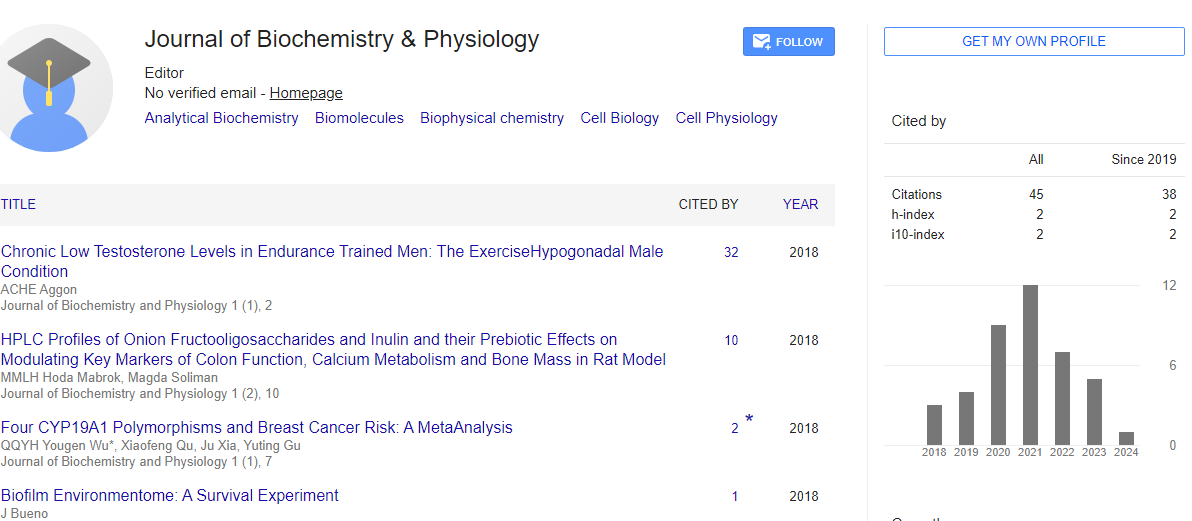Perspective, J Biochem Physiol Vol: 7 Issue: 1
Mitochondrial Function and Cellular Bioenergetics: Key Players in Cell Physiology
Chng Wa*
1Department of Molecular Cell Biology, University of Groningen, Groningen, The Netherlands
*Corresponding Author: Chng Wa,
Department of Molecular Cell Biology,
University of Groningen, Groningen, The Netherlands
E-mail: wachn@g.cn
Received date: 19 February, 2024, Manuscript No. JBPY-24-134955;
Editor assigned date: 21 February, 2024, PreQC No. JBPY-24-134955 (PQ);
Reviewed date: 11 March, 2024, QC No. JBPY-24-134955;
Revised date: 20 March, 2024, Manuscript No. JBPY-24-134955 (R);
Published date: 29 March, 2024, DOI:10.4172/jbpy.1000153.
Citation: Wa C (2024) Mitochondrial Function and Cellular Bioenergetics: Key Players in Cell Physiology. J Biochem Physiol 7:1.
Description
Mitochondria are called as powerhouse of the cell, and for good reason. These organelles play a central role in cellular bioenergetics, generating the majority of the cell's energy in the form of Adenosine Triphosphate (ATP). Beyond energy production, mitochondria are involved in numerous other cellular processes, including calcium signaling, apoptosis, and redox homeostasis. This article explores the essential role of mitochondrial function in cellular physiology and the intricate interplay between mitochondria and various cellular pathways.
Mitochondria are double-membraned organelles consisting of an outer membrane, an inner membrane, and an intermembrane space. The inner membrane is highly folded with cristae, which increase the surface area available for ATP production. Within the inner membrane lies the Electron Transport Chain (ETC), a series of protein complexes (Complexes I-IV) that transfer electrons derived from fuel molecules to molecular oxygen. This process drives the pumping of protons across the inner membrane, creating an electrochemical gradient that fuels ATP synthesis by ATP synthase (Complex V) in a process known as oxidative phosphorylation.
The production of ATP in mitochondria is a complex and highly regulated process that involves multiple metabolic pathways. The primary fuel sources for ATP production are carbohydrates, lipids, and amino acids. Carbohydrates are converted to pyruvate through glycolysis in the cytoplasm, which is then transported into the mitochondria and further oxidized to acetyl-CoA. Acetyl-CoA enters the citric acid cycle (Krebs cycle), where it undergoes a series of redox reactions to generate reducing equivalents (NADH and FADH2) that feed electrons into the ETC. Lipids are broken down into fatty acids and enter the mitochondria through beta-oxidation, while amino acids can be metabolized to produce intermediates that feed into the citric acid cycle.
Mitochondrial function is tightly regulated to meet the energy demands of the cell and adapt to changing metabolic conditions. Key regulators of mitochondrial biogenesis and function include the Peroxisome Proliferator-Activated Receptor Gamma Coactivator 1- alpha (PGC-1α), Nuclear Respiratory Factors (NRFs), and Mitochondrial Transcription Factor A (TFAM). These transcriptional coactivators orchestrate the expression of nuclear and mitochondrial genes involved in oxidative phosphorylation, mitochondrial dynamics, and mitochondrial quality control.
In addition to their role in energy production, mitochondria are involved in cellular signaling pathways that regulate various aspects of cell physiology. Mitochondria serve as hubs for calcium signaling, acting as buffers for cytosolic calcium ions and participating in the regulation of calcium-dependent processes such as muscle contraction and apoptosis. Mitochondrial dysfunction can lead to calcium overload and trigger cell death pathways, highlighting the importance of mitochondrial calcium homeostasis in cell survival.
Mitochondria are dynamic organelles that undergo constant fission and fusion events to maintain their integrity and function. Mitochondrial dynamics are regulated by a network of proteins, including dynamin-related GTPases such as mitofusins and Dynamin- Related Protein 1 (Drp1). Dysregulation of mitochondrial dynamics is associated with various diseases, including neurodegenerative disorders and metabolic syndromes. Additionally, mitochondria employ quality control mechanisms, such as mitophagy and the Mitochondrial Unfolded Protein Response (UPRmt), to remove damaged mitochondria and maintain cellular homeostasis.
Mitochondrial dysfunction is implicated in a wide range of human diseases, including neurodegenerative disorders, metabolic diseases, and cancer. Mutations in mitochondrial DNA (mtDNA) or nuclear genes encoding mitochondrial proteins can impair oxidative phosphorylation and ATP production, leading to energy depletion and cellular dysfunction. Therapeutic strategies aimed at restoring mitochondrial function, such as mitochondrial replacement therapy and mitochondrial-targeted antioxidants, hold promise for the treatment of mitochondrial diseases.
Conclusion
Mitochondrial function is essential for cellular bioenergetics and plays a critical role in cell physiology and disease. By generating ATP and participating in cellular signaling pathways, mitochondria regulate various aspects of cellular function, including metabolism, calcium homeostasis, and cell death. Understanding the complex interplay between mitochondria and cellular pathways is crucial for elucidating the mechanisms of disease pathogenesis and developing targeted therapies for mitochondrial disorders.
 Spanish
Spanish  Chinese
Chinese  Russian
Russian  German
German  French
French  Japanese
Japanese  Portuguese
Portuguese  Hindi
Hindi 